Spontaneous Generation
Recreation of Pasteur’s Experiment
Background — Spontaneous Generation
In this experiment, you will be recreating Pasteur’s famous
experiment that disproved spontaneous generation and investigating the
conditions under which bacteria will/will not grow.
Today, we take many things in science for granted. Many
experiments have been performed and much knowledge has been accumulated that
people didn’t always know. For centuries, people based their beliefs on
their interpretations of what they saw going on in the world around them
without testing their ideas to determine the validity of these theories — in
other words, they didn’t use the scientific method to arrive at
answers to their questions. Rather, their conclusions were based on
untested observations.
Among these ideas, for centuries, since at least the time of
Aristotle (4th Century BC), people (including scientists) believed that
simple living organisms could come into being by
spontaneous generation.
This was the idea that non-living objects can give rise to living
organisms. It was common “knowledge” that simple organisms like worms,
beetles, frogs, amd salamanders could come from dust, mud, etc., and food
left out, quickly “swarmed” with life. For example:
Observation: Every year in the spring,
the Nile River flooded areas of Egypt along the river, leaving behind
nutrient-rich mud that enabled the people to grow that year’s crop of food.
However, along with the muddy soil, large numbers of frogs appeared that
weren’t around in drier times. - Conclusion: It was perfectly obvious to people back then that
muddy soil gave rise to the frogs.
Observation: In many parts of
Europe, medieval farmers stored grain in barns with thatched roofs (like
Shakespeare’s house). As a roof aged, it was not uncommon for it to start
leaking. This could lead to spoiled or moldy grain, and of course there
were lots of mice around. - Conclusion: It was obvious to them that the mice came from the
moldy grain.
Observation: In the cities,
there were no sewers, no garbage trucks, no electricity, and no refrigeration.
Sewage flowed in the gutters along the streets, and the sidewalks
were raised above the streets to give people a place to walk. In the
intersections, raised stepping stones were strategically placed to allow
pedestrians to cross the intersection, yet were spaced such that carriage
wheels could pass between them. In the morning, the contents of the chamber
pots were tossed out the nearest window. Food was purchased and prepared on
a daily basis, and when people were done eating a meal,
the bones and left-overs were tossed out the window, too. A chivalrous
gentleman always walked closest to the street when escorting a woman, so if
a horse and carriage came by and splashed up the filth flowing in the
gutters, it would land on him, and not the lady’s expensive silk gown (many
of these gowns were so ornately embroidered
that they were not easily washable, and neither washing machines nor dry
cleaners existed). Many cities also had major rat problems.
People back then may or may not have not connected the presence of rats with
the spread of Bubonic Plague (Black
Death, a dreaded and fatal disease), but they were probably bothered by the
rats chewing on things and by the rat fleas biting them
(just as cat/dog owners, even now, are bitten by the offspring of their pet’s
fleas). People may not have realized that the Plague was spread by
the bites of those fleas, but I imagine they knew that if only they could
get rid of the rats, the pesky fleas would soon disappear, too — hence the
story of the Pied Piper of Hamelin, Germany, leading all the rats out of
town. - Conclusion: Obviously, all the sewage and garbage turned into
the rats.
Observation: Since there were
no refrigerators, the mandatory, daily trip to the butcher shop, especially
in summer, meant battling the flies around the carcasses. Typically,
carcasses were “hung by their heels,” and customers selected which chunk the
butcher would carve off for them. - Conclusion: Obviously, the rotting meat that had been hanging in
the sun all day was the source of the flies.
From this came a number of interesting recipes, such
as:
- Recipe for bees:
- Kill a young bull, and bury it in an upright position so that its horns
protrude from the ground. After a month, a swarm of bees will fly out of
the corpse.
- Jan Baptista van Helmont’s recipe for mice:
- Place a dirty shirt or some rags in an open pot or barrel containing a
few grains of wheat or some wheat bran, and in 21 days, mice will
appear. There will be adult males and females present, and they will be
capable of mating and reproducing more mice.
Disproving Spontaneous Generation
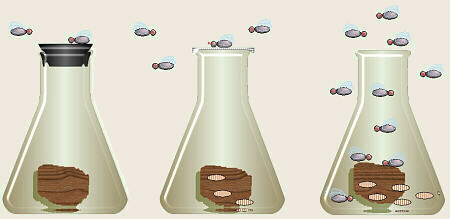 In 1668, Francesco Redi, an Italian physician, did an experiment with
flies and wide-mouth jars containing meat. This was a true scientific
experiment — many people say this was the first real
experiment — containing the following elements:
In 1668, Francesco Redi, an Italian physician, did an experiment with
flies and wide-mouth jars containing meat. This was a true scientific
experiment — many people say this was the first real
experiment — containing the following elements:
- Observation: There are flies
around meat carcasses at the butcher shop.
- Question: Where do the flies
come from? Does rotting meat turn into or produce the flies?
- Hypothesis: Rotten meat does
not turn into flies. Only flies can make more flies.
- Prediction: If meat cannot
turn into flies, then rotting meat in a sealed (fly-proof) container should
not produce flies or maggots.
- Testing: Wide-mouth jars each
containing a piece of meat were subjected to several variations of
“openness” while all other variables were kept the same.
- control group — These jars of meat were set out without lids
so the meat would be exposed to whatever it might be in the butcher
shop.
- experimental group(s) — One group of jars were sealed with lids,
and another group of jars had gauze placed over them.
- replication — Several jars were included in each group.
- Data: Presence or absence of
flies and maggots observed in each jar was recorded. In the control group of
jars, flies were seen entering the jars. Later, maggots, then more flies
were seen on the meat. In the gauze-covered jars, no flies were seen in the
jars, but were observed around and on the gauze, and later a few maggots were
seen on the meat. In the sealed jars, no maggots or flies were ever seen on
the meat.
- Conclusion(s): Only flies can
make more flies. In the uncovered jars, flies entered and laid eggs on the
meat. Maggots hatched from these eggs and grew into more adult flies.
Adult flies laid eggs on the gauze on the gauze-covered jars. These eggs or
the maggots from them dropped through the gauze onto the meat. In the sealed
jars, no flies, maggots, nor eggs could enter, thus none were seen in those
jars. Maggots arose only where flies were able to lay eggs. This experiment
disproved the idea of spontaneous generation for larger organisms.
After this experiment, people were willing to acknowledge that
“larger” organisms didn’t arise by spontaneous generation, but had
to have parents. With the development and refinement of the microscope in
the 1600s, people began seeing all sorts of new life forms such as yeast and
other fungi, bacteria, and various protists. No one knew from where these
organisms came, but people figured out they were associated with things like
spoiled broth. This seemed to add new evidence to the idea of spontaneous
generation — it seemed perfectly logical that these minute organisms should
arise spontaneously. When Jean Baptiste Lamarck proposed his theory of
evolution, to reconcile his ideas with Aristotle’s Scala naturae, he
proposed that as creatures strive for greater perfection, thus move up the
“ladder,” new organisms arise by spontaneous generation to fill the
vacated places on the lower rungs.
In 1745 to 1748, John Needham, a Scottish clergyman and
naturalist showed that microorganisms flourished in various soups that had
been exposed to the air.
He claimed that there was a “life force” present in the molecules
of all inorganic matter, including air and the oxygen in it, that could
cause spontaneous generation to occur, thus accounting for the presence of
bacteria in his soups. He even briefly boiled some of his soup and poured
it into “clean” flasks with cork lids, and microorganisms
still grew there.
A few years later (1765 to 1767), Lazzaro Spallanzani, an
Italian abbot and biologist,
tried several variations on Needham’s soup experiments. First, he boiled
soup for one hour, then sealed the glass flasks that contained it by melting
the mouths of the flasks shut. Soup in those flasks stayed sterile. He then
boiled another batch of soup for only a few minutes before sealing the flasks,
and found that microorganisms grew in that soup. In a third batch, soup was
boiled for an hour, but the flasks were sealed with real-cork corks (which,
thus, were loose-fitting enough to let some air in), and microorganisms grew
in that soup. Spallanzani concluded that while one hour of boiling would
sterilize the soup, only a few minutes of boiling was not enough to kill any
bacteria initially present, and the microorganisms in the flasks of spoiled
soup had entered from the air.
This initiated a heated argument between Needham and Spallanzani
over sterilization (boiled broth in closed vs. open containers) as a way of
refuting spontaneous generation. Needham claimed that Spallanzani’s
“over-extensive” boiling used to sterilize the containers had
killed the “life force.” He felt that bacteria could not develop
(by spontaneous generation)
in the sealed containers because the life force could not get in, but in the
open container, the broth rotted because it had access to fresh air, hence
the life force inherent in its molecules, which contained and replenished
the life force needed to trigger spontaneous generation. In the
minimally-boiled flasks, he felt the boiling was not severe enough to
destroy the life force, so bacteria were still able to develop.
By 1860, the debate had become so heated that the Paris
Academy of Sciences offered a prize for any experiments that would help
resolve this conflict. The prize was claimed in 1864 by Louis Pasteur, as
he published the results of an experiment he did to
disproved spontaneous generation in these microscopic organisms.
- Observation(s): From
Needham’s and Spallanzani’s experiments, it was
known that soup that was exposed to the air spoiled — bacteria grew in it.
Containers of soup that had been boiled for one hour, and then were sealed,
remained sterile. Boiling for only a few minutes was not enough to sterilize
the soup. Pasteur had previously demonstrated that the dust collected by
drawing air through a cotton ball contained large numbers of bacteria, hence
he knew that bacteria were present in the air and could be filtered out by
using a cotton ball. He also knew that bacteria would settle out on the
walls of a long, bent, glass tube as air was passed through it.
- Question: Is there indeed a
“life force” present in air
(or oxygen) that can cause bacteria to develop by spontaneous generation? Is
there a means of allowing air to enter a container, thus any life force, if
such does exist, but not the bacteria that are present in that air?
- Hypothesis: There is no such life force in air, and a container of
sterilized broth will remain sterile, even if exposed to the air, as long as
bacteria cannot enter the flask.
- Prediction: If there is no
life force, broth in swan-neck flasks
should remain sterile, even if exposed to air, because any bacteria in the
air will settle on the walls of the initial portion of the neck. Broth in
flasks plugged with cotton should remain sterile because the cotton is able
to filter bacteria out of the air.
- Testing: Pasteur boiled
broth in various-shaped flasks to sterilize
it, then let it cool. As the broth and air in the containers cooled, fresh
room air was drawn into the containers. None of the flasks were sealed — all
were exposed to the outside air in one way or another.
- control group — Some flasks opened straight up, so not only air,
but any bacteria present in that air, could get into them.
- experimental group(s) — Pasteur used some flasks with long,
S-shaped necks (swan-neck flasks) and closed others with cotton plugs.
This allowed air to enter these flasks, but the long, swan neck or the
cotton balls filtered out any bacteria present in that air. He
subsequently broke the long necks off some of the swan-neck flasks.
- replication — Pasteur used several flasks in each of his groups.
According to one freshman biology text, some of his original flasks, on
display (in France), still are sterile.
- Data: Broth in flasks with
necks opening straight up
spoiled (as evidenced by a bad odor, cloudiness in previously clear broth,
and microscopic examination of the broth confirming the presence of bacteria),
while broth in swan-neck flasks did not, even though fresh air could
get it. Broth in flasks with cotton plugs did not spoil, even though air
could get through the cotton. If the neck of a swan-neck flask was broken
off short, allowing bacteria to enter, then the broth became
contaminated.
- Conclusion(s): There is no
such life force in air, and organisms
do not arise by spontaneous generation in this manner. To quote Louis
Pasteur, “Life is a germ, and a germ is Life. Never will the doctrine of
spontaneous generation recover from the mortal blow of this simple
experiment.”
One very important point to note here is that Pasteur did not seek to find
an answer to the broad question, “Has spontaneous generation ever
occurred?” Rather, as any good scientist, he limited his scope to a very
narrow piece of the picture: “Is it possible for spontaneous generation to
occur given the specific conditions under which Needham (and others)
claims it will occur,” i.e. the “life force?” Interestingly,
in 1936, when Alexander Ivanovich Oparin, a Russian scientist, published
The Origins of Life, in which he described hypothetical conditions
which he felt would have been necessary for life to first come into
existence on early Earth, some scientists found it difficult to acknowledge
that under the very different conditions which Oparin was proposing for
early Earth, some form of “spontaneous generation” might indeed
have taken place.
Bibliography
Alcamo, I. Edward. 1997. Fundamentals of Microbiology, 5th Ed.
Benjamin Cummings Publ. Co., Menlo Park, CA. (pp. 7-9)
Curtis, Helena. 1983. Biology, 4th Ed. Worth Publ. NY. (pp.
77-78, 238)
Lewis, Ricki. 1992. Life. Wm.C. Brown. Dubuque, IA. (p.
59)
Schroeder, Gerald L. 1990. Genesis and the Big Bang. Bantam
Books. NY. (pp. 107-110)
The
Slow Death of Spontaneous Generation (1668-1859)
Recreation of Pasteur’s Experiment
Materials Needed
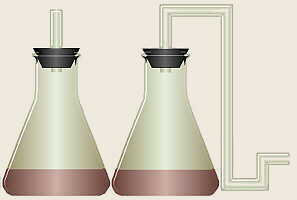
- low-salt broth (chicken or beef, home-made or purchased)
- 2 250-mL Erlenmeyer flasks
- 2 1-hole rubber stoppers (size 8) with bent glass tubing inserted (see diagram)
A note on the type of broth used: Salt is used as a
preservative (think of some cured ham that’s so salty it can be left at room
temperature without spoiling). If the external environment around a cell
(including bacterial cells) is very salty, water from within the cell will
flow out of the cell to the more-salty, exterior environment. That dehydrates
the cell, usually killing it. In this experiment, we want to show the
difference in bacterial growth following various sterilization treatments or
storage methods, without having a lot of salt present in the broth that might
interfere with or inhibit the growth of bacteria. Thus, it is best to use
low-salt broth.
Safety Considerations
- If Bunsen burners are used, refer to that protocol for important safety
information.
- If you will be bending your own glass, remember to observe these
additional safety rules:
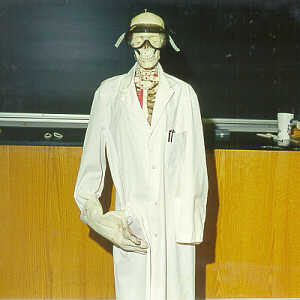
Wear Goggles and Gloves
- Goggles should be worn so unexpected pieces of glass don’t get into
your eyes.
- When breaking glass tubing, first score the desired breaking point
with a file. Then, WEARING THICK GLOVES or with the tubing WRAPPED IN A
THICK TOWEL and the score mark facing away from you, gently “bend” the
breaking point AWAY FROM YOU until it snaps.

Wear Gloves
- The ends of the tubing you will be using should be fire-polished
using a large (Meker-Fisher) burner. Glass tubing cools very slowly, so
don’t touch the hot ends accidentally. Wearing heat-resistant gloves is
a good idea.
- To bend a piece of glass, rotate the tubing while heating the desired
location over a large (Meker-Fisher) burner until the glass softens.
Keep the tubing in the flame while you make the desired bend, then remove
the tubing from the flame so it will begin to cool.
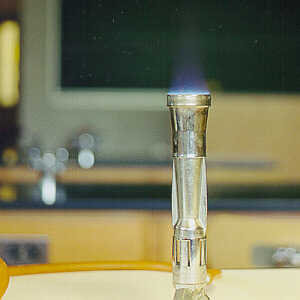
Meker (Meker-Fisher) Burner
(larger and hotter than a Bunsen burner)
- Always use a lubricant when inserting glass tubing into a rubber
stopper. A drop or two of glycerol or soapy water will make insertion
fairly easy. When inserting glass into a stopper, always wear thick
gloves that also protect your wrists, and hold the tubing near the
stopper (not several inches away). To make insertion easier,
twist/rotate the tubing as you gently push it into the stopper — if
properly lubricated, insertion should be nearly “effortless.”
Procedure
Note that these are general directions. Students are
encouraged to design their own experiments. Glass tubing may be bent into
any desired shape or left straight. Tubing may or may not be inserted,
and/or a no-hole stopper may be used. Optionally, the end of a tube may be
plugged with a bit of cotton. Beef or chicken broth (or other?) may be used.
Broth may be unboiled or may be boiled for varying lengths of time, either
in a “double boiler” in a pan of water or over a Bunsen burner. Stoppers
may be inserted before or after boiling, and/or broth may be boiled in
another container and poured into a “clean” flask. Broth could be stored at
different temperatures (refrigerator, room temperature, incubator). PLEASE
CLEARLY MARK ALL FLASKS AS TO CONTENTS, TREATMENT, AND OWNER(S).
- Students should work in teams of 2
to 3 people. Each team should perform the following steps.

Broth and Flask
- Decide what combinations of lid,
tubing, openness, boiling or not, boiling time, boiling in flask vs pouring
in later, presence/absence of cotton “plug,” etc. you wish to test.
Mark Erlenmeyer flasks accordingly. The two suggestions listed here would
be most like the equipment that Pasteur used.
- flask with stopper and
glass tube going straight up
- flask with stopper and glass
tube bent in S-curve
- Place about 50 mL of broth in each
Erlenmeyer flask.
- Place appropriate lids on flasks.

Boiling the Broth

Four Flasks Set Up
- Boil broth in flasks with appropriate
lids on them for 30 min., then let cool. Optionally, you may decide to
boil some broth separately, let it cool a bit, then pour it into a “clean”
flask. For comparison, you may also decide to not boil the broth in one
flask. You could also compare boiling for 5 min vs boiling for 20 or
30 min. Note: if you’re boiling the broth in a flask for 30 min, it must
be a very slow boil so all your broth doesn’t evaporate — watch your flask
as it boils so it doesn’t boil dry and burn!

Colonies Growing in Broth
- For the next several lab periods,
observe the flasks and record any changes in color, turbidity, smell,
etc. Caution: if you remove the lid from (“open”) a flask to examine it,
and leave the lid off for any significant amount of time or set the lid down
on the desk, etc., any of those actions may introduce bacteria into a flask
that might otherwise have been sterile, thereby changing the outcome of
your experiment. To avoid possible contamination, it’s better to observe
your flasks without removing the lids.
Remember to record what you did and how you set up your experiment (draw
pictures, too). Take notes on any changes in appearance or smell of your
flask(s), and compare data with other students in your lab section.
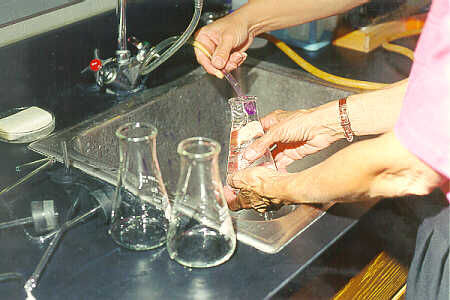
Clean Up When You’re Done!
- When you are finished observing your
flasks, CLEAN UP! Make sure to thoroughly wash all glassware. Do NOT
attempt to remove glass tubing from stoppers — another class can use them
in the future.
Other Things to Include in Your Notebook
Make sure you have all of the following in your lab notebook:
- all handout pages (in notebook or separate protocol book)
- all notes you take during the introductory mini-lecture
- all notes and data you gather as you perform the experiment
- drawing (yours!) of your flasks/lids
- answers to all discussion questions, a summary/conclusion in your
own words, and any suggestions you may have
- any returned, graded pop quiz
Copyright © 1999 by D. B. Fankhauser and J. Stein Carter. All rights reserved.
Based on printed protocol Copyright © 1999 D. B. Fankhauser and J. L. Stein Carter.
This page has been accessed  times since 14 Mar 2001.
times since 14 Mar 2001.
 In 1668, Francesco Redi, an Italian physician, did an experiment with
flies and wide-mouth jars containing meat. This was a true scientific
experiment — many people say this was the first real
experiment — containing the following elements:
In 1668, Francesco Redi, an Italian physician, did an experiment with
flies and wide-mouth jars containing meat. This was a true scientific
experiment — many people say this was the first real
experiment — containing the following elements:
 In 1668, Francesco Redi, an Italian physician, did an experiment with
flies and wide-mouth jars containing meat. This was a true scientific
experiment — many people say this was the first real
experiment — containing the following elements:
In 1668, Francesco Redi, an Italian physician, did an experiment with
flies and wide-mouth jars containing meat. This was a true scientific
experiment — many people say this was the first real
experiment — containing the following elements:








